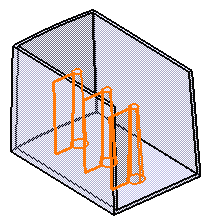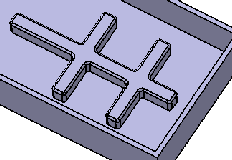About Ribs and Posts | ||||
|
| |||
About Profiles
About creating posts: In addition to points, sketches can contain curves, which enables you to
obtain results as illustrated below: 
Extension Type
To define the extension type, you can set one of the options available from the Extension type list:
- No extension: confines the rib to be created only within the walls of the shelled volume, even if the profile is outside the walls of the volume. For an example, see Creating a Rib.
-
Across removed face: is similar to
No extension but the rib is not confined
within the wall of the deleted face of the shelled volume.

- Add all: creates the rib based on the
specified length and width values, even if the values cause the rib to protrude
outside of the volume to which it is applied.

- Subtract all: subtracts the volume of the
rib from the volume to which it is applied.

Fillet Tab
When you have the rib with the ends of the open profiles, you can add
the fillets at the ends of the open profile with Lateral
radius and
Fillet profile ends options.
Fillet profile ends can be combined with other
radius options. See
Creating a Prism
for some examples.

If you want to add an intersection fillet, you can choose between Intersection with Core/Cavity, Intersection with Core or Intersection with Cavity in the Type box under Intersection fillet. If you want to add material to the feature, select the Fillet radius check box if you want to remove material from the feature, select the Round radius check box.
Select the Preserve shell thickness check box if you want to keep the thickness applied on the feature.
Thin Solid
To define a thin solid, you can set one of the options available from the Type list:
- Use body thickness: The rib wall thickness is that of the active shelled body thickness.
- Enter thickness: Enter the value you want. When this option is selected, the Thicknes box is available. Wall thickness values can only by positive values.
Posts Tab
Distance tab lets you choose between three types of elements used for neutral elements for applying the taper angle. These elements are:
- Profile plane
- First limit: The reference uses the first limit. The
Up to Surface option is used for the first limit.

- Second limit: The reference uses the second limit.
The draft properties defined by the draft options can be used in the post options for creating a rib feature. In this case, the draft angle value appears in the Taper Angle box. This option is then disabled and dimmed.